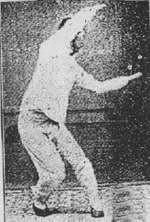Sun Lutang
Sun Lu-t'ang or Sun Lutang (1860-1933) was a renowned master of Chinese neijia (internal) martial arts and was the progenitor of the syncretic art of Sun-style t'ai chi ch'uan.[1] He was also considered an accomplished Neo-Confucian and Taoist scholar (especially in the I Ching), and was a distinguished contributor to the theory of internal martial arts through his many published works.[2]


| 孫祿堂 Sun Lu-t'ang | |
|---|---|
 Portrait of the Chinese, neijia martial arts master Sun Lu-t'ang. | |
| Born | Sun Fuquan (孫福全) 1860 Hebei, China |
| Died | 1933 (aged 72–73) |
| Nationality | Chinese |
| Style | Sun-style taijiquan, Baguazhang, Xingyiquan |
| Teacher(s) | Xingyiquan: Li Kuiyuan (李魁元), later Guo Yunshen (from 1882) Baguazhang: Cheng Tinghua (from 1891) Wu (Hao)-style taijiquan: Hao Wei-chen (from 1911) |
| Rank | Founder of Sun-style taijiquan Founder of Sun style Baguazhang |
| Website | Sun-style website |
| Sun Lutang | |||||||
|---|---|---|---|---|---|---|---|
| Traditional Chinese | 孫祿堂 | ||||||
| Simplified Chinese | 孙禄堂 | ||||||
| |||||||
| Sun Fuquan | |||||||
| Chinese | 孫福全 | ||||||
| |||||||
| Part of a series on |
| Chinese martial arts (Wushu) |
|---|
 |
| Wushu in the world |
|
Historical locations
|
| Wushu athletes/practitioners |
|
Legendary figures
|
|
Historical individuals
|
|
Modern celebrities
|
| Wushu influence |
Biography
He was born in Hebei and was named Sun Fuquan (孫福全) by his parents. Years later, his Baguazhang teacher Cheng Tinghua (程延華) gave him the name Sun Lutang. (It was common in old China for people to have multiple names). He continued to use his original name in some areas, including the publishing of his books.
He was also well-versed in two other internal martial arts: xingyiquan (hsing-i ch'uan) and baguazhang (pa-kua chang) before he came to study taijiquan (t'ai chi ch'uan). His expertise in these two martial arts were so high that many regarded him as without equal. Sun learned Wu (Hao)-style t'ai chi ch'uan from Hao Wei-chen.[1] Sun started studying with Hao relatively late in his life, but his accomplishments in the other two internal arts led him to develop his t'ai chi abilities to a high standard more quickly than is usual.
He subsequently was invited by Yang Shao-hou, Yang Chengfu and Wu Chien-ch'üan to join them on the faculty of the Beijing Physical Education Research Institute where they taught t'ai chi to the public after 1914.[2] Sun taught there until 1928, a seminal period in the development of modern Yang, Wu and Sun-style t'ai chi ch'uan.[2]
Family
In 1891 he married Zhang Zhouxian, with whom he had three sons and a daughter.
- First son, Sun Xingyi (孫星一; 1891-1929)
- Second son, Sun Cunzhou (孫存周; 1893-1963)
- Third son, Sun Wuzi (孫务滋; 1897-1922)
- Daughter, Sun Jianyun (孫劍雲; 1913-2003)
Teachers
- Xingyiquan from Li Kuiyuan (李奎垣), and later from Guo Yunshen (郭雲深) (from 1882).
- Baguazhang from Cheng Tinghua (程延華) (from 1891).
- Wu (Hao)-style taijiquan from Hao Wei-chen (郝為眞) (from 1911).
T'ai chi ch'uan lineage tree with Sun-style focus
Note:
- This lineage tree is not comprehensive, but depicts those considered the 'gate-keepers' & most recognised individuals in each generation of Sun-style.
- Although many styles were passed down to respective descendants of the same family, the lineage focused on is that of the Sun style & not necessarily that of the family.
| Key: | NEIJIA | ||||||||||||||||||||||||||||||||||||||||||||||||
| Solid lines | Direct teacher-student. | ||||||||||||||||||||||||||||||||||||||||||||||||
| Dot lines | Partial influence /taught informally /limited time. | TAIJIQUAN | |||||||||||||||||||||||||||||||||||||||||||||||
| Dash lines | Individual(s) omitted. | ||||||||||||||||||||||||||||||||||||||||||||||||
| Dash cross | Branch continues. | CHEN-STYLE | Zhaobao-style | ||||||||||||||||||||||||||||||||||||||||||||||
| YANG-STYLE | |||||||||||||||||||||||||||||||||||||||||||||||||
| WU (HAO)-STYLE | Zhaobao He-style | ||||||||||||||||||||||||||||||||||||||||||||||||
| Li-style | (郝為真) Hao Weizhen 1849–1920 3rd gen. Wu (Hao) | ||||||||||||||||||||||||||||||||||||||||||||||||
| WU-STYLE | (孙禄堂) Sun Lutang 1861–1932 SUN-STYLE | ||||||||||||||||||||||||||||||||||||||||||||||||
| (孙存周) Sun Cunzhou 1893–1963 2nd gen. Sun | (孙剑云) Sun Jianyun 1913–2003 2nd gen. Sun | ||||||||||||||||||||||||||||||||||||||||||||||||
| Wudang-style | (孙婉容) Sun Wanrong 1927–Present 3rd gen. Sun | ||||||||||||||||||||||||||||||||||||||||||||||||
| CHEN-STYLE | YANG-STYLE | WU-STYLE | SUN-STYLE | WU (HAO)-STYLE | |||||||||||||||||||||||||||||||||||||||||||||
Publications
In later life, he published five martial arts texts which were also later translated to English recently:
- Xingyiquan xue (A study of form mind boxing) 1915
- Baguaquan xue (A study of eight trigrams boxing) 1916
- Taijiquan xue (A study of grand ultimate boxing) 1921
- Baguajian xue (A study of eight trigrams straight sword) 1927
- Quanyi Shuzhen (An explanation of the essence of boxing)
He also wrote a study of Bagua spear, though this was never published.
References
- Yip, Li (Faye) (April 1998). "Principles and Practice of Sun Style T'ai Chi – T'AI CHI The International Magazine of T'ai Chi Ch'uan Vol. 22 No. 2". Wayfarer Publications. ISSN 0730-1049. Cite journal requires
|journal=(help) - Wile, Douglas (1995). Lost T'ai-chi Classics from the Late Ch'ing Dynasty (Chinese Philosophy and Culture). State University of New York Press. ISBN 978-0-7914-2654-8.
External links
- Sun-style website
- Sun-style researched
- Sun-style Forum
- Sun's Tai Chi Research Institute - seccion sudamerica
(Wayback Machine copy)